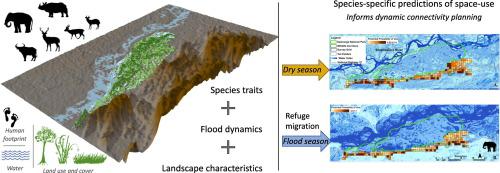Science of the Total Environment ( IF 8.2 ) Pub Date : 2020-12-04 , DOI: 10.1016/j.scitotenv.2020.144000 Varun R. Goswami , Divya Vasudev , Bhavendu Joshi , Prity Hait , Pragyan Sharma

|
With climate change, terrestrial fauna in riparian floodplain ecosystems must adapt to a predicted increase in frequency and magnitude of fluvial perturbations. Here, we demonstrate the opportunities and constraints large-bodied mammalian herbivores face during an adaptive response of obligatory flood-driven refuge migration, across a human-dominated environment. We contrast species distribution data during a major flood event with those from the dry season to illustrate season-specific movement and space use decisions of large herbivores ranging in body size from the 3000-kg Asian elephant Elephas maximus to the 20-kg muntjac Muntiacus muntjak. In the dry season, most large herbivores––a majority of which are endangered and threatened by anthropogenic pressures––avoided areas with a strong human footprint, while preferring spaces with high land-use diversity. During the floods, such species were pushed out of inundated habitats within a protected area, and they chose to move through woodlands and areas under bamboo cover on private lands, as they migrated to forested refugia on higher ground. Our results show how seasonal environmental constraints shaped by floods determine the internal motivation of animals to risk traversing a human-dominated space to seek refuge, which contextually defines how animals view and navigate the landscape. Such insights underscore the importance of dynamic and adaptive conservation planning to facilitate connectivity in the changing environment and climate of the present Anthropocene.
中文翻译:

动态洪泛区景观中气候强迫和人类足迹对野生动植物活动和空间使用决策的耦合影响
随着气候变化,河岸漫滩生态系统中的陆地动物必须适应河流扰动的频率和强度的预期增加。在这里,我们展示了在人类主导的环境中,强制性洪水驱动的避难所迁移的适应性响应过程中,大型食草动物面临的机遇和制约因素。我们将重大洪水事件期间的物种分布数据与干旱季节的物种分布数据进行对比,以说明大型食草动物的特定季节运动和空间使用决策,这些食草动物的体型范围从3000公斤亚洲象最大象到20公斤孟子Muntiacus muntjak。在干旱季节,大多数大型草食动物(其中大部分受到人为压力的威胁和威胁)避免了人类足迹旺盛的地区,而偏爱具有高土地利用多样性的空间。在洪水期间,这些物种被赶出了受保护区域内被淹没的栖息地,它们选择迁移到林地和私人土地上被竹子掩盖的区域,然后迁移到高地上的森林避难所。我们的研究结果表明,洪水造成的季节性环境限制如何决定动物冒险穿越人为主导的避难所的内部动机,这在上下文上定义了动物如何观看和导航景观。











































 京公网安备 11010802027423号
京公网安备 11010802027423号